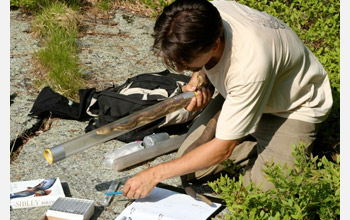Multimedia Gallery
Rattlesnakes Sound Biodiversity Warning
Rulon Clark, a herpetologist and assistant professor at San Diego State University, handles timber rattlesnakes in the field to get tissue samples. Here he is using a tubing method to safely handle a snake--the snake crawls into the plastic tube and is gently held in place.
More about this Image
Rulon Clark (a former Cornell University postdoctoral researcher) and a team of researchers from Cornell used fine-scale molecular genetics, behavioral and ecological data, and microsatellite markers, to track timber rattlesnakes in four regions of upstate New York. The purpose of the study was to find out how wildlife habitats are affected by human encroachment and to investigate the general processes underlying population-level responses to habitat fragmentation.
They discovered that even small habitat modifications by human encroachment can create significant barriers to gene flow. In particular, the fragmentation of natural habitats by roads (even small, low-traffic roads), can make populations less genetically diverse, which in turn can make them more susceptible to disease or environmental changes that threaten their survival. The study found that this has had a significant effect on the genetic structure of timber rattlesnakes in New York over the past 80 years.
Clark and his research team used fine-scale molecular genetics and behavioral and ecological data to look at timber rattlesnakes from 19 different hibernacula (shared wintering quarters) from different locations in four regions of New York: the Adirondacks, Sterling Forest, Bear Mountain and Chemung County. Using microsatellite markers, the team tracked the populations as they dispersed from their winter dens; their subsequent reproductive patterns; and how roads in these areas altered that gene flow. The roads themselves--all of which were paved and built in the late 1920s to early 1930s for motorized traffic--were examined for use and relationship to natural barriers. Tissue samples from more than 500 individual snakes were examined.
The results of the study were published in a paper, "Roads, Interrupted Dispersal and Genetic Diversity in Timber Rattlesnakes," in the August 2010 issue of Conservation Biology. The paper states that, "Over all four regions and 19 hibernacula, none of the genetic clusters spanned either major or minor roads; hibernacula belonging to the same genetic deme (a local population of organisms of one species) were always on the same side of the road. This fine-scaled analysis, repeated over four geographic regions, underscores the significance of roads as barrier to dispersal and natural population processes for timber rattlesnakes and perhaps other species."
The study's findings--as well as the findings from previous studies on other terrestrial animals, from grizzly bears to frogs--are a warning about habitat fragmentation, and should be taken into consideration when plans are made for future human development. [Research supported by National Science Foundation grant DEB 02-33850, and by the New York State Biodiversity Research Institute.] (Date of Image: 2008)
Credit: Rulon Clark, San Diego State University
Images and other media in the National Science Foundation Multimedia Gallery are available for use in print and electronic material by NSF employees, members of the media, university staff, teachers and the general public. All media in the gallery are intended for personal, educational and nonprofit/non-commercial use only.
Images credited to the National Science Foundation, a federal agency, are in the public domain. The images were created by employees of the United States Government as part of their official duties or prepared by contractors as "works for hire" for NSF. You may freely use NSF-credited images and, at your discretion, credit NSF with a "Courtesy: National Science Foundation" notation.
Additional information about general usage can be found in Conditions.
Also Available:
Download the high-resolution JPG version of the image. (311 KB)
Use your mouse to right-click (Mac users may need to Ctrl-click) the link above and choose the option that will save the file or target to your computer.

